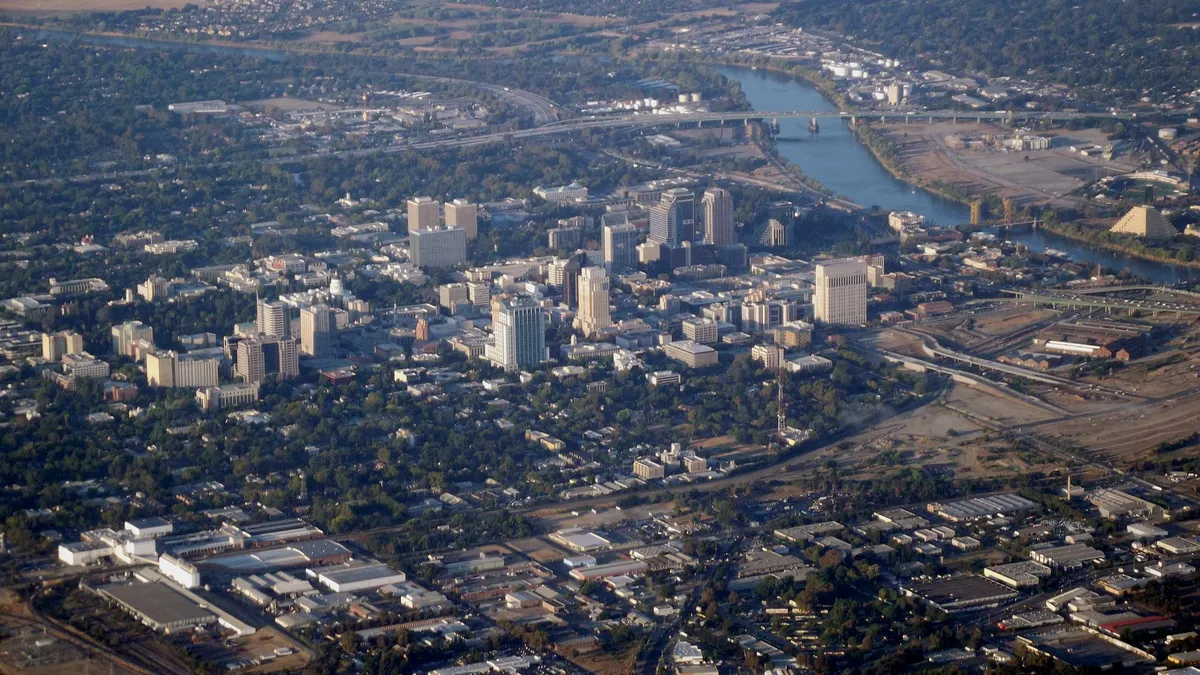Dive Brief:
- The Sacramento Municipal Utility District (SMUD) last week committed to delivering carbon-neutral electricity by 2030, 15 years ahead of California's broader goal of supplying 100% of electricity from zero-carbon and renewable energy resources by 2045.
- The commitment is included in a "climate emergency declaration" that was unanimously approved by SMUD's board of directors last Thursday, setting the utility on the path to "finding reductions in the quickest way possible and investing in our most vulnerable communities," SMUD Board President Rob Kerth said in a statement.
- The move reflects a broader cultural transition among the country's utilities, according to Natalia Mathura, principal, utility business models at the Smart Electric Power Alliance (SEPA), where "utilities and municipalities are taking responsibility and truly evaluating the scientific evidence that is available for them to use to make decisions."
Dive Insight:
There are 56 utilities in the country that have public carbon or emissions reduction goals, according to SEPA's utility carbon reduction tracker, while 25 utilities have committed to carbon-free or net-zero emissions by 2050. Most of them are aiming to achieve this around the 2045 to 2050 timeline, according to Mathura, making SMUD's timeline particularly aggressive.
For utilities, adopting carbon reduction goals typically entail long processes and internal debate, Mathura said, and creating the cultural change of making this "mission critical" is one of the larger challenges for them.
"You have to get the buy-in from the capacity planners and the project managers and the smart grid technical groups internally, to all operate under this same mission" of building and designing programs that are carbon free, she explained.
SMUD, a publicly-owned utility that serves a roughly 1.5 million population, recorded around 1,755,000 tonnes of greenhouse gas emissions in 2018 — a 50% reduction of 1990 levels, or the equivalent of removing 377,000 vehicles from the road, the declaration noted.
In 2018, the utility adopted a plan to achieve carbon neutrality by 2040, five years ahead of California's goal. The plan identified a roadmap that included $7 billion in investments over the next two decades, which included nearly 2,900 MW of new carbon-free resources, including 1,500 MW of utility-scale solar, 670 MW of wind and 560 MW of utility-scale energy storage.
The declaration approved by the board on Thursday would accelerate that goal by a decade. SMUD's staff will now work on a report identifying strategies and plans to achieve the goal.
"[I] just want to underscore that the purpose of this is really just to acknowledge something that's painfully obvious to anybody who's paying attention. … Climate change is accelerating and it truly is an emergency," SMUD Board Director Dave Tamayo said during the virtual meeting Thursday. "It's not just an idle declaration, it's really intended to back up very serious action by staff," he added.
In the two years following SMUD's approval of a 2040 carbon neutrality goal, California has had three record-setting wildfire seasons, Chris Brown, coordinator of the Sacramento Climate Coalition, told Utility Dive.
"It's clear that some of the board members were feeling like things were shifting in terms of the climate as a whole," he said.
SMUD's goal is ambitious, but current requirements will bring the utility pretty close to achieving them, Mark Specht, energy analyst with the climate and energy program at the Union of Concerned Scientists, told Utility Dive. California has a 60% RPS by 2030 goal, and about a quarter of SMUD's electricity comes from large hydropower already, he explained.
"So assuming they keep that percentage of large hydro and meet RPS [targets] in 2030, they'd actually be at 85% clean energy already," he said.
The challenge now is to figure out a mix of replacement power, Brown added. "But the dropping costs of battery storage are going to be part of the solution here. Already, the costs are much lower than when SMUD looked at these same set of questions in 2018 for their [integrated resource plan]."
The changing energy mix will also present SMUD with technical challenges, Specht said.
"They'll need to learn how to operate their grid with much higher levels of renewables and battery storage. … We all have some learning to do," he added.















